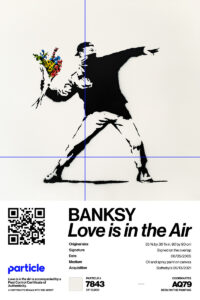Decentralized autonomous organizations or DAOs, are collectively owned, blockchain-governed groups pooling resources and expertise to work toward a shared mission. And in a decentralized field, they’re growing in number as much as popularity — from single-purpose communities like ConstitutionDAO, to art-collecting groups like Salon seeking to democratize access to the art world, to collectives such as Arkive with massive ambitions to create new models for decentralized museums.
Popularity aside, many DAOs are already operating as effective mechanisms for change and advocacy, overlapping with and pushing the traditional boundaries of the cultural sector. Groups like Ukraine DAO and PleasrDAO have produced millions of dollars for social change by selling and buying NFTs. Other groups work to create more inclusive and equitable Web3 spaces, seeking to empower emerging creators by collecting, sharing, and investing in their art.
More than the “new Web3 thing,” these collectives are actively changing the way we’ve traditionally thought about organization, art ownership, and community governance. Here are just some DAOs that have made all the difference on-chain and IRL.
Flamingo DAO

Since 2020, Flamingo DAO has acquired a sizable collection of digital art spanning pioneering works by Yuga Labs, Kevin Abosch, and Snowfro. Image: Flamingodao.xyz
Established in October 2020, Flamingo is a member-run DAO exploring investment opportunities for blockchain-based assets. Per its Twitter, its community represents “a flamboyance of collectors, curators, and artists — Medici’s of NFTs,” with members holding voting rights by purchasing Flamingo Units. Now valued at $1 billion, Flamingo’s portfolio is now composed of CryptoPunks, Bored Apes, Chromie Squiggles, and Autoglyphs.
As Flamingo’s success has sent the buy-in price for a membership soaring (from about 60 ETH to 3,000 ETH), their mission has continued to fossilize and their collection has grown. Between acquiring NFTs, commissioning work from artists like Hackatao, and curating its works in public digital museums and gallery showings, the DAO is showcasing a penchant for both operating as a museum and capitalizing on the development of existing assets. For example, after purchasing an Alien CryptoPunk for $750,000 in 2021, the DAO gave the NFT a social media account and turned it into a personality, using it as the face of the internet museum MUSE0.
Ukraine DAO

In the midst of Russia’s invasion, Ukraine DAO has been key in raising some $7 million in crypto donations to aid the country’s war efforts. Image: Ukraine DAO
Ukraine DAO was launched at the start of Russia’s invasion into Ukraine, and serves to “raise funds to donate to Ukrainian civilian organizations” that are offering humanitarian support. The DAO is led by Ukrainian activist Alona Shevchenko, along with individuals from Trippy Labs and PleasrDAO.
Since February, the DAO has donated more than $7 million in support of the Ukrainian war efforts. Organized both on and offline, the DAO has coordinated charity, war relief, and evacuation efforts through its fundraising and its auctioning of 10,000 Ukrainian flag NFTs, which is now the 10th most expensive NFT ever sold. As Shevchenko told Decrypt, “Creating a DAO is a good way to get international and Web3 attention and give the Ukrainian people a voice. This is exactly what DAOs are for, making change offline in the real world [by] harnessing the power of blockchain.”
The group remains active since its donation of $7 million in March, with an active presence on Twitter, community events, and an online hub on Notion that has a plethora of resources and materials on Ukrainian culture, history, and people, as well as ways to get involved past donating.
Unicorn DAO

While collecting art created by women, non-binary and LGBTQ+ creators, Unicorn DAO hopes to “give birth to a queer utopia in the Metaverse.” Image: Sufdah series by Melissa Wiederrecht / @UnicornDAO on Twitter
Co-founded by Pussy Riot’s Nadya Tolokonnikova and her network of crypto OGs, Unicorn DAO has ambitions that are, simply put — ambitious. The collective’s work seeks to “actually change the values” of Web2, in Tolokonnikova’s words, to ensure that Web3 will be different, “especially before mass adoption happens.” Early members of Unicorn DAO include Beeple, Grimes, and Guy Oseary.
As noted in a report by ArtTactic, female-identified artists made up only 5 percent of NFT sales in 2021. Accordingly, Unicorn aims to “give birth to a queer utopia in the Metaverse,” to collect and showcase art created by women, non-binary and LGBTQ+ creators, fund businesses led by women, non-binary and LGBTQ+ individuals, and provide historically undervalued and underrepresented groups tools to empower themselves.
In early 2022, the DAO raised $4.5 million and has already purchased $1.4 million in art from under-represented groups in the Web 3.0 space including work from Olive Allen, DeadFellaz and Sad Girls Bar, working towards its goal of offering exposure and support for female-identifying artists in the NFT space.
PleasrDAO

Though best known for its internet-baiting acquisitions, PleasrDAO has shown a commitment toward charitable causes. Image: Pleasr.org
PleasrDAO — a collective of DeFi leaders, early NFT collectors, and digital artists — collects “digital art that represents and funds important ideas, movements and causes.” The DAO has been making a splash with high-profile acquisitions like Wu-Tang Clan’s singular and unreleased Once Upon a Time in Shaolin album and the original Doge meme.
Those internet-baiting purchases aside, the DAO has been experimenting with community art ownership and value sharing between funding culturally significant and additive pieces. “In the previous Web2 capitalistic world, it’s very competitive, we have limited resources, or rather we’re taught to think we have very limited resources,” noted the DAO’s pplpleasr. But with Web3, “we have a chance to start over… it’s not a zero-sum mindset anymore.”
The DAO is certainly rooted in the principles of giving back. Over its lifetime, the DAO has backed the acquisition of “x*y=k,” an animation piece by pplpleasr to support the #StandWithAsians movement; half-a-million dollars was raised and donated to charity within a day. Pleasr has also acquired the “Stay Free” NFT by Edward Snowden, raising $5 million for Freedom of the Press Foundation in the process. In the future, the DAO hopes to find a way to share Once Upon a Time in Shaolin with the public, in the true spirit, the DAO wrote, of “Wu-Tang Clan’s protest against middleman overlords.”
Particle Collection

Particle’s first acquisition, “Love is in the Air” by Banksy, has been exhibited in Miami and Los Angeles — showings decided on by its token-holders. Image: Particle
ParticleDAO is billed as the first permission-less collector DAO in history, with co-founders hailing from Christie’s, Ethos.io, Voyager, and Uber. Aiming to democratize art ownership, the collective plans to acquire “humanity’s greatest masterpieces,” while allowing “a wider population to hold digital ownership.” The collection process includes sourcing and acquiring works by promising artists, then fractionalizing the art and selling tokens to the community. These fractions are used as governance tokens, with NFT holders holding privileged access to the works and voting rights to make painting-specific decisions such as where the physical work may be presented.
So far, the DAO has acquired “Love is in the Air” by Banksy. It fractionalized the work into 10,000 particles for $1,500 a piece, which were randomly allocated to its bidders. The work was displayed at the Institute of Contemporary Art, Miami, during Miami Art Week in 2021, and most recently, was on display at the Praz-Delavallade in Los Angeles, with Particle holders being able to visualize their particles onsite by scanning a QR code. In the future, the DAO aims to establish both a metaverse and physical museum, with Particle tokens acting as tickets and with decisions being made by the collective.



